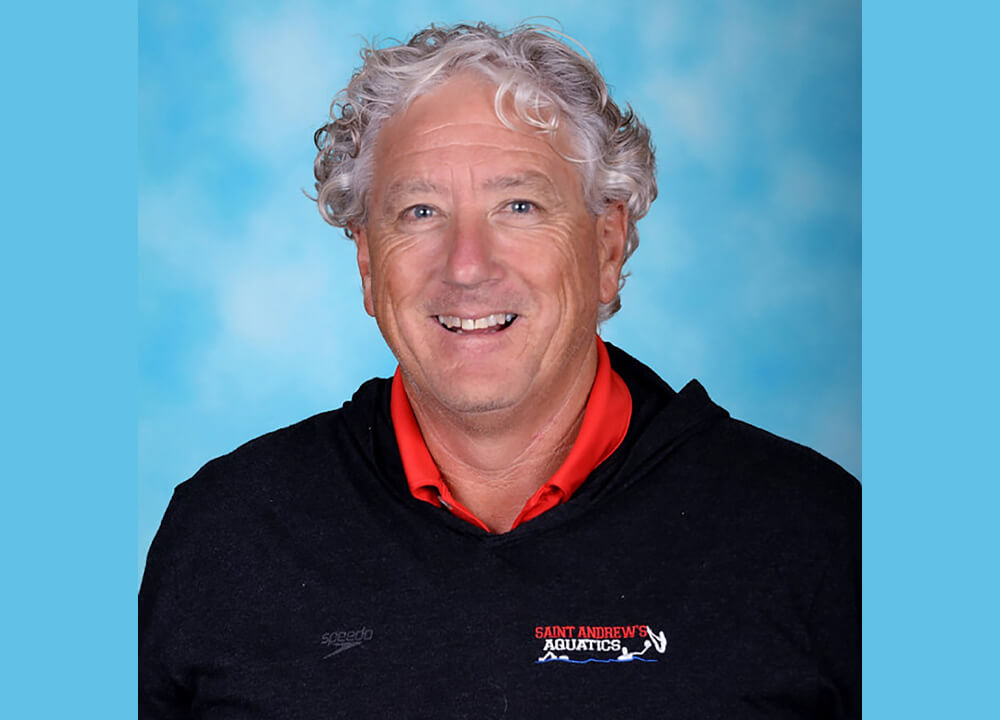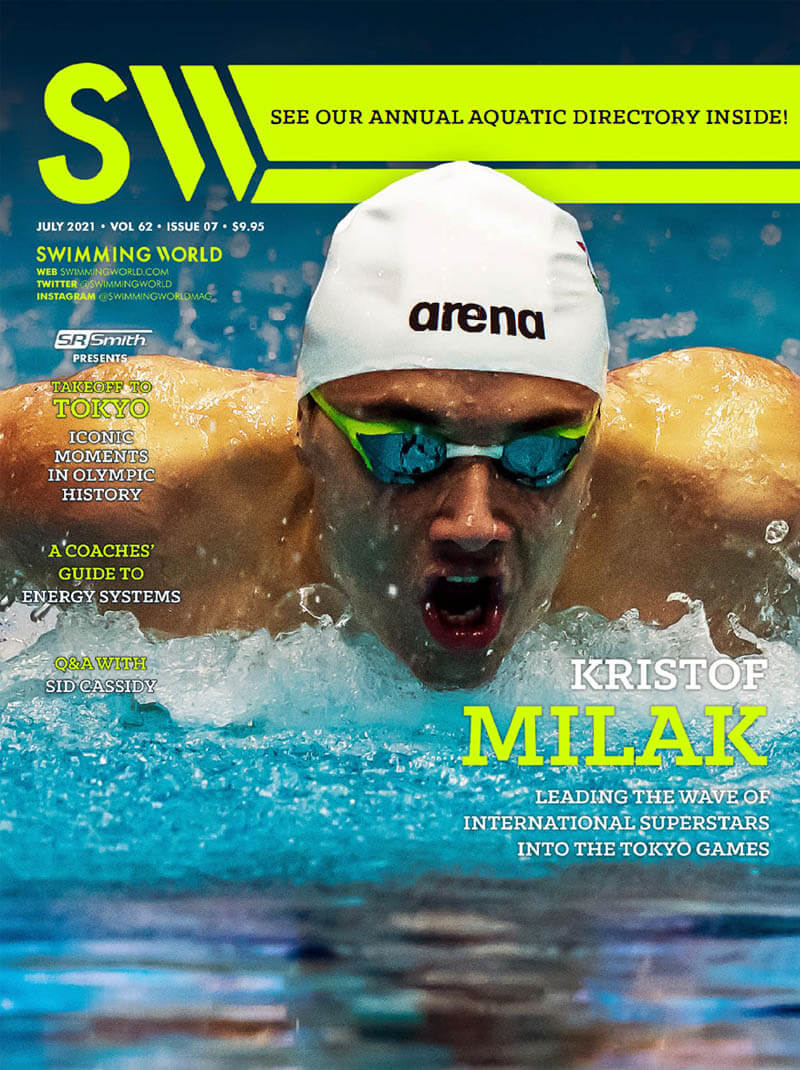Swimming World July 2021 Issue Presents – Q&A with St. Andrews Coach Sid Cassidy

The latest issue of Swimming World Magazine
is now available for download in the Swimming World Vault!
Non-Subscribers Can Download This Issue Here
Q&A with St. Andrew’s Coach Sid Cassidy
By Michael J. Stott
Jovial and dedicated Sid Cassidy has given his life to his family, teams and all forms of swimming—especially open water.
Coach Sid Cassidy has been an inter-national open water steward for more than 40 years, serving as athlete, coach, race director, promoter, administrator, referee, lecturer and the FINA Technical Open Water Swimming Committee chairman. With FINA, he has organized and run the Olympic 10K Marathon Swim, FINA 10K Marathon Swimming World Cup and the FINA Open Water Swimming Grand Prix circuit.
CREDENTIALS
• University of California, San Diego, B.A., mass communications/media studies, 1979
• 3x CSCAA All-American, 11x ACC champion, North Carolina State University
• Professional marathon swimmer, world-ranked fourth, 1979
• Aquatic director/head coach, Saint Andrew’s School, 2005-present
• Aquatic director/head coach, Atlantic City, 1998-2005
• Head coach, University of Miami, 1993-98
• Men’s head coach, James Madison University, 1992-93
• Assistant coach, Florida State, 1985-92
• Assistant coach, University of Tampa, 1983-85; head coach, Greater Tampa Swimming Association
• U.S. open water national team coach, 1991-96; coached and swam on record-setting USA Swimming National Team English Channel double crossing
• Board member of the International Marathon Swimming Hall of Fame
• 5x Florida High School coach of the year
• Halls of Fame inductee: International Marathon Swimming, North Carolina Swimming, Ocean City Beach Patrol, Delaware Museum and Sports
• Recipient of USA Swimming Award plus Paragon, Glenn S. Hummer and Irving Davids-Captain Roger Wheeler Memorial awards
Q. SWIMMING WORLD: Is it fair to say Bob Mattson influenced your life?
A. COACH SID CASSIDY: Without question and in many ways. We swimmers stood in awe of his prodigious work ethic fueled by an incredible passion to explore, experiment and achieve. He was at the cutting edge of many technical breakthroughs, including experimentation with the wave breaststroke and other drills that truly solidified him as a coaching legend. Bob is still very much in my life on many levels. I just hosted a Zoom celebration for his 90th birthday!
SW: How did NCSU coach Don Easterling advance your swimming career?
SC: He was an incredible motivator and knew how to squeeze every last bit of effort out of you in a training session. His old school methods may not transfer into modern aquatic times, but he did pour a bucket of passion into his daily coaching. Those years were formative for me.
SW: How did you get into coaching in the first place?
SC: After agreeing to split ways with Coach Easterling in 1977, I transferred to UCLA, where I spent one season training under the legendary George Haines. Ultimately, I ended up at UC San Diego, where I got into ocean swimming and beach lifeguarding. And I really honed my open water racing tactics as a member of the famed Ocean City (N.J.) Beach Patrol under Captain George Lafferty. In the summer of 1979, I got a desperate call from Bob Mattson, who pleaded with me to just try coaching for a year with his club program. I felt a certain calling, and as a result, fell in love with coaching.
SW: You’ve coached college, club and high school programs.
SC: Each position has unique challenges, but the rewards are always the same: gratification upon seeing an athlete complete a challenge set or achieve a breakthrough competitive experience.
SW: These days, coaching is a family affair, is it not?
SC: Absolutely. Our children, Quinn and Kate, have enjoyed collegiate aquatic success, and we have been able to grow the program at Saint Andrew’s School into a competitive force. Presently, two of my coaches are Quinn and Ramon Walton, who I call my “second son.” My wife, Kara, has built an incredible Florida Swim School business housed in our own indoor pool, which has been integral to our success for 20-plus years, so it really is a family enterprise.
Michael J. Stott is an ASCA Level 5 coach, golf and swimming writer. His critically acclaimed coming-of-age golf novel, “Too Much Loft,” was published in June 2021, and is available from Bookbaby.com, Amazon, B&N and book distributors worldwide.
Get Swimming World Magazine and Swimming World Biweekly FREE When You
Become A Member of the International Swimming Hall of Fame
New! 30 Day Membership to ISHOF AND Digital Swimming World Subscription for just $10 a month!
Want more? Get a 1 Year ISHOF Family Membership With Swimming World Print AND Digital Subscription Order Now!
Non-Subscribers can click here to download this issue for only $5.94
FEATURES
010 | TOKYO OLYMPIC GAMES: READY FOR IMPACT
by Dan D’Addona, Matthew De George, John Lohn, David Rieder and Andy Ross
As the United States was still selecting its Olympic swimming team in mid-June, most countries had already decided who would be competing at the COVID-19 pandemic-delayed Olympic Games this summer. Here are profiles of 10 swimmers from around the world who have been preparing to make an impact in Tokyo.
022 | TAKEOFF TO TOKYO: ICONIC MOMENTS IN OLYMPIC HISTORY
by John Lohn
In October of 2019, nearly a year prior to the original date of the 2020 Olympic Games in Tokyo, Swimming World designed a series that would pay homage to the history of the sport on its biggest stage. For our final installment of “Takeoff to Tokyo,” we offer a look at some of the most prominent moments in Olympic lore.
026 | AS GOOD AS IT GETS
by Dan D’Addona
In our Olympic preview of artistic swimming, Swimming World notes that Russia is a perfect 10-for-10, winning every Olympic gold medal possible—duet and team—since the turn of the century. Led by Svetlana Romashina and Svetlana Kolesnichenko, Russia will be tough to beat next month, Aug. 2-7, in Tokyo.
COACHING
20 | SWIMMING TECHNIQUE CONCEPTS: MAXIMIZING SWIMMING VELOCITY (Part 3)—MINIMIZING THE ARM ENTRY PHASE TIME IN FREESTYLE AND BUTTERFLY
by Rod Havriluk
The non-propulsive time in a stroke cycle consists of the time for the entry phase and the recovery phase. This article presents strategies to minimize the entry phase time for freestyle and butterfly so that a swimmer can decrease stroke cycle time, increase stroke rate and increase swimming velocity.
040 | A COACHES’ GUIDE TO ENERGY SYSTEMS (Part 2)
by Michael J. Stott
Last month, Swimming World explored the concept of energy systems and how coaches can use them to maximize athlete development and performance. In Part 2, we examine how one incorporates his understanding of energy systems into a seasonal training plan.
042 | Q&A WITH COACH SID CASSIDY
by Michael J. Stott
043 | HOW THEY TRAIN MEGAN MORONEY AND ASPEN GERSPER
by Michael J. Stott
TRAINING
019 | DRYSIDE TRAINING: SUMMER SPEED
by J.R. Rosania
JUNIOR SWIMMER
45 | UP & COMERS: KAYLA HAN
by Shoshanna Rutemiller
COLUMNS & SPECIAL SECTIONS
008 | A VOICE FOR THE SPORT
018 | THE OFFICIAL WORD
027 | 2021 AQUATIC DIRECTORY
046 | GUTTERTALK
047 | PARTING SHOT
Swimming World is now partnered with the International Swimming Hall of Fame. To find out more, visit us at ishof.org




